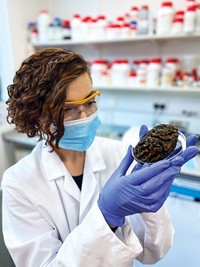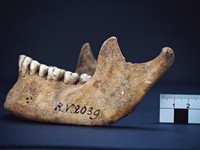Advertisement
Grab your lab coat. Let's get started
Welcome!
Welcome!
Create an account below to get 6 C&EN articles per month, receive newsletters and more - all free.
It seems this is your first time logging in online. Please enter the following information to continue.
As an ACS member you automatically get access to this site. All we need is few more details to create your reading experience.
Not you? Sign in with a different account.
Not you? Sign in with a different account.
ERROR 1
ERROR 1
ERROR 2
ERROR 2
ERROR 2
ERROR 2
ERROR 2
Password and Confirm password must match.
If you have an ACS member number, please enter it here so we can link this account to your membership. (optional)
ERROR 2
ACS values your privacy. By submitting your information, you are gaining access to C&EN and subscribing to our weekly newsletter. We use the information you provide to make your reading experience better, and we will never sell your data to third party members.
Analytical Chemistry
Molecules As Fossils
Mass spectrometry is helping paleontologists dig up molecular clues about prehistoric creatures
by Bethany Halford
March 20, 2006
| A version of this story appeared in
Volume 84, Issue 12

There was a time when a paleontologist's tool kit consisted of little more than a hand pick, a hammer, and a magnifying glass. But outfitting a paleontologist in the 21st century is a considerably more high-tech endeavor.
The "New Approaches to Paleontological Investigation" symposium at last month's American Association for the Advancement of Science annual meeting in St. Louis highlighted how high-tech tools have become indispensable in paleontology. Scientists can now study fossils in greater detail than ever, thanks to state-of-the-art computers and instrumentation such as magnetic resonance imaging, computer-assisted tomography, and mass spectrometry.
And it's not just bones they're scrutinizing. A new wave of researchers is ferreting out ancient molecules from within these fossils, hoping to find out how prehistoric creatures lived and evolved. Considering the speed with which this technology is moving forward, the next big discoveries in paleontology could come from scientists who are more familiar with peptide fragments than they are with pterosaur femurs.
"Molecules are fossils, too," said Peggy H. Ostrom, a biogeochemist at Michigan State University. "When you examine a bone or a tooth, you can get some sort of idea about the fossil from its structure. You know if it's a femur or if it came from a carnivore versus an herbivore. In molecules, the same thing is true. We've shown that proteins survive in very old fossils, and proteins can tell us about diseases, about where prehistoric animals fit in the food chain, what they ate, and who they are related to."
Ostrom is one of a handful of scientists studying proteins from fossils, a field that's been dubbed "paleoproteomics" (C&EN, April 21, 2003, page 51). These researchers use mass spectrometry to determine the sequence of ancient proteins. "The advent of soft-ion mass spectrometry has really revolutionized the way we work," noted Matthew J. Collins of BioArch, a joint venture of the archaeology, biology, and chemistry departments at the University of York, in England.

Searching for a molecular record in fossils isn't a new idea. Amplification techniques previously have allowed scientists to study ancient DNA from fossils (C&EN, March 29, 2004, page 34), but the method has some drawbacks. Ancient DNA can easily become contaminated with modern DNA. Nucleic acids don't always stand the test of time either. Most prehistoric DNA samples are less than 50,000 years old and come from permafrost, frozen soil in high latitudes.
"Permafrost doesn't necessarily contain the most interesting things," Collins pointed out. In warmer climates, prehistoric molecules tend to degrade more quickly. So, Collins observed, a molecule that has held up for a few hundred years in England has achieved the same chemical feat as one surviving for thousands of years in permafrost.
Certain proteins, however, have proven to be far more resilient than DNA. Osteocalcin, a protein found exclusively in bone tissue, is so hardy that Ostrom was able to extract it from 500,000-year-old musk ox bones. Because osteocalcin is present only in vertebrates, researchers are confident that the protein originated in the fossil and is not an artifact left over by common contaminators, such as bacteria or plants.
Ostrom attributes osteocalcin's staying power to its close association with bone's mineral phase. Carboxylic acid-containing residues of the protein bind five calcium ions within hydroxyapatite crystals, which shelter the protein from the ravages of time.
Ostrom recently used a paleoproteomic approach to unravel the sequence and structure of osteocalcin from a 42,000-year-old horse bone found in Juniper Cave, Wyo. (Geochim. Cosmochim. Acta, published online Feb. 21, dx.doi.org/10.1016/j.gca.2006.01.004). According to Collins, recovering protein from a fossil that's spent tens of thousands of years in Wyoming's warmer climate is a remarkable feat. In chemical terms, he told C&EN, the fossil is much older than a permafrost sample of that age would be.
When Ostrom compared the ancient horse's osteocalcin with that of three modern equine species-a horse, a zebra, and a donkey-Ostrom found that the peptide sequences of all four were identical. "That tells us there hasn't been a lot of evolutionary change from zebra to donkey to horse," she said.
Collins similarly compared osteocalcin from 75,000-year-old Neanderthal fossils with that of a modern human, a gorilla, a chimpanzee, and an orangutan (Proc. Natl. Acad. Sci. USA 2005, 102, 4413). The sequences of Neanderthals and humans were exactly the same but differed from those of the primates.
From an evolutionary standpoint, the osteocalcin sequence has proven to be highly conserved during time frames that have been investigated thus far. That doesn't mean the technique hasn't yielded insights. Collins, for example, used osteocalcin sequence analysis to determine if a set of prehistoric bones came from sheep or goats. Although the bones of sheep and goats are similar, the animal husbandry of sheep differed greatly from that of goats in prehistoric times. Correctly identifying the remains was important for archaeologists trying to draw conclusions about the site where the remains were found.
Ostrom admits that while proteins are not as informative as DNA, they still provide scientists with molecular clues. "Even if there's only partial information, it's still going to tell us something," she said.
Collins pointed out that the molecular structure of ancient proteins also can provide valuable information. By examining how the amino acids degrade, through racemization or oxidation, for example, his lab is working out a method of telling the fossil's chemical age.
"From a chemist's point of view, these ancient proteins are very interesting because you can see all types of modification," said Philip C. Andrews, a professor of biological chemistry at the University of Michigan Medical School who collaborates with Ostrom. "Mass spectrometry has changed incredibly in the last 10 years. We have dramatically increased sensitivity and accuracy, and we have new fragmentation technology that we did not have 10 years ago or even five years ago."
"In the early 1990s, we couldn't have done these experiments on modern proteins, let alone ancient ones," Ostrom added.
Hoping to observe more prominent evolutionary changes in the molecular record, scientists are trying to expand the technique to look at older proteins and proteins that evolve more quickly than osteocalcin. Ostrom is trying to sequence osteocalcin from a 7 million-year-old equine tooth.
One recent, related report about soft tissue extracted from a 68 million-year-old Tyrannosaurus rex has researchers particularly excited: When paleontologist Mary H. Schweitzer of North Carolina State University dissolved mineralized bone fragments from the dinosaur, she found what seemed to be blood vessels and osteocytes-cells found in mature bone (Science 2005, 307, 1952). Sequencing proteins from this material could provide fascinating insights.
Paleoproteomics has huge potential for applications, Collins said. "We're very excited about the possibilities of getting into some interesting stuff."





Join the conversation
Contact the reporter
Submit a Letter to the Editor for publication
Engage with us on Twitter